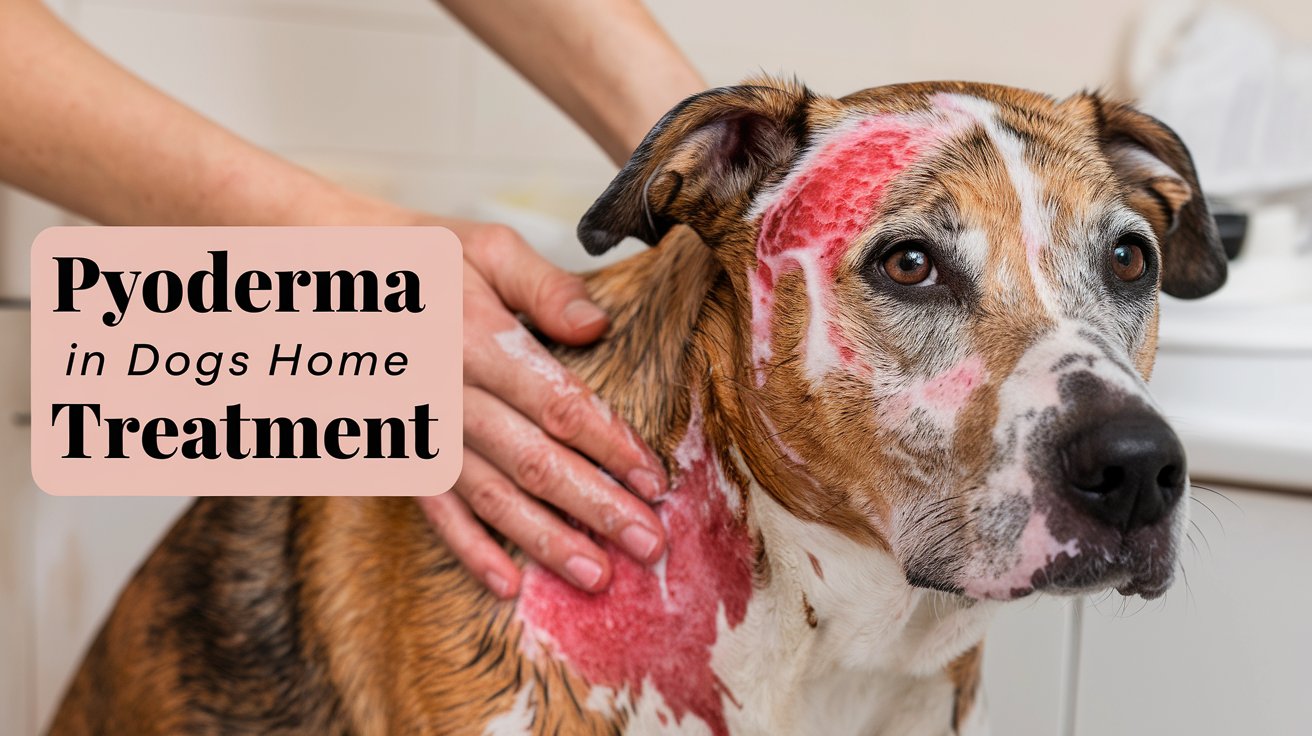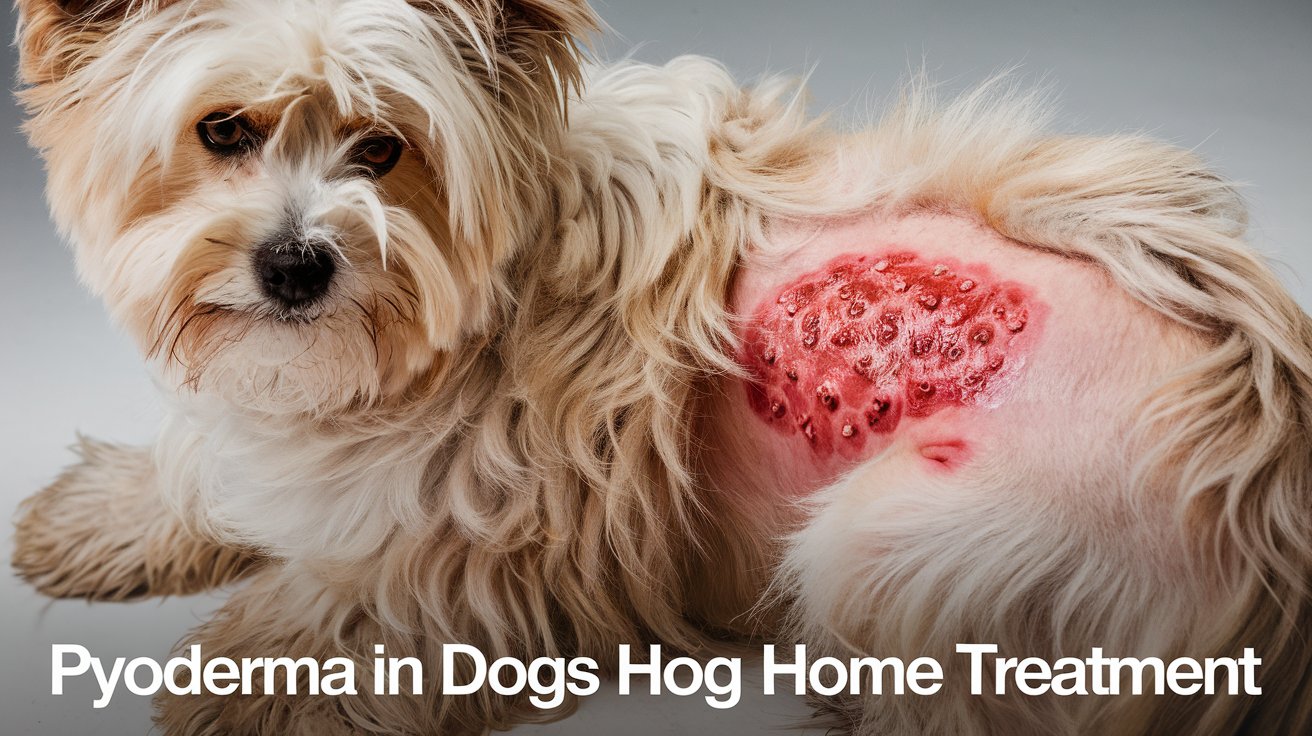
Understanding Pyoderma in Dogs and Effective Home Treatment Options
Dogs are often regarded as man’s best friend, providing love, companionship, and security. However, just like humans, dogs can experience various skin conditions, including pyoderma, that affect their comfort and health. Pyoderma is a bacterial skin infection that can lead to significant discomfort if not treated promptly. While veterinary care is crucial, many pet owners seek natural, at-home remedies to complement traditional treatments. In this article, we’ll explore the causes, symptoms, and types of pyoderma in dogs and focus on home treatment options that can alleviate your dog’s suffering.
What is Pyoderma in Dogs?
Pyoderma in dogs refers to a bacterial skin infection characterized by pus-filled sores, inflammation, and itchiness. The term “pyoderma” comes from the Greek words “pyo,” meaning pus, and “derma,” meaning skin. This condition is commonly caused by bacteria such as Staphylococcus pseudintermedius, which are part of the dog’s natural skin flora but can become problematic under certain circumstances.
Dogs with weakened immune systems, allergies, or those prone to moist environments are more likely to develop pyoderma. The condition is not only uncomfortable for the dog but can also progress into more severe infections if not addressed promptly. However, with proper diagnosis and a well-planned treatment strategy, most cases of pyoderma can be managed successfully.
Causes of Pyoderma in Dogs
Understanding the root cause of pyoderma in dogs is essential in determining the appropriate course of treatment. The condition can arise due to various factors, including:
- Allergies: Dogs suffering from environmental, food, or flea allergies are more likely to develop pyoderma as they tend to scratch and irritate their skin.
- Skin Trauma: Cuts, abrasions, or constant licking can lead to bacterial infection, triggering pyoderma.
- Endocrine Disorders: Dogs with hypothyroidism or Cushing’s disease often have compromised immune systems, making them more susceptible to infections like pyoderma.
- Parasites: Fleas, ticks, and mites can irritate the skin, creating the ideal environment for bacteria to thrive.
- Moist Environments: Hot spots, or areas where moisture is trapped due to folding skin or heavy fur, can lead to bacterial growth and pyoderma.
- Autoimmune Diseases: In some cases, an underlying immune condition may be the cause of recurring pyoderma.
Symptoms of Pyoderma in Dogs
The symptoms of pyoderma in dogs can vary depending on the severity of the infection and the affected area. Common signs to watch for include:
- Red, inflamed skin
- Pustules or pimples filled with pus
- Hair loss in the affected areas
- Itchiness and scratching
- Crusty or scabby skin lesions
- Foul odor from the skin
- Pain or sensitivity when the affected area is touched
In some cases, pyoderma can be localized (restricted to a small area) or generalized, affecting large portions of the dog’s body. The skin condition may be superficial or deep, with the latter often requiring more intensive care.
Types of Pyoderma in Dogs
There are different types of pyoderma in dogs, categorized based on the depth of the infection and its location:
- Superficial Pyoderma: This is the most common form and affects only the upper layers of the skin. It typically causes redness, scaling, and the formation of pustules.
- Deep Pyoderma: This more severe type involves infection that penetrates deeper layers of the skin, leading to abscesses, severe swelling, and pain.
- Juvenile Pyoderma: Seen in puppies, this form of pyoderma may appear as facial swelling, ulcers, or sores and requires prompt medical attention.
- Fold Pyoderma: Occurs in areas where skin folds, such as the face, armpits, or groin. These areas trap moisture, encouraging bacterial growth.
Each type of pyoderma may require different approaches for treatment, and understanding the specific nature of the infection is key to effective management.

Pyoderma in Dogs Home Treatment: Natural Remedies and Care
For pet owners wondering about pyoderma in dog’s home treatment, the good news is that several home remedies and lifestyle adjustments can complement veterinary care and promote faster healing. However, it’s important to consult with your vet before starting any home treatment to ensure it aligns with your dog’s specific needs.
1. Regular Cleaning and Disinfection
Keeping the affected area clean is one of the most important aspects of treating pyoderma at home. Use a mild antiseptic solution or diluted chlorhexidine to gently clean the infected skin. Regular cleaning helps remove bacteria and prevents the infection from spreading.
- How to Clean: Gently apply a clean, damp cloth to the affected area. Use a veterinary-recommended antiseptic solution or mix a small amount of salt in warm water. Clean the area twice daily until the symptoms improve.
2. Topical Antibacterial Ointments
Applying topical antibacterial ointments can help control bacterial growth and soothe irritated skin. Products containing natural ingredients like honey or coconut oil have antibacterial properties and are safe for most dogs.
- Honey: Raw honey is a natural antiseptic and can be applied to the sores to reduce bacteria and inflammation.
- Coconut Oil: Known for its antimicrobial properties, coconut oil can be massaged into the skin to relieve irritation and moisturize the area.
3. Aloe Vera Gel
Applying fresh aloe vera gel to the infected area can reduce inflammation and promote healing. Aloe vera is safe for external use in dogs and can be applied twice a day.
- How to Use: Extract fresh aloe vera gel from a leaf and gently apply it to the affected area. Allow it to dry naturally before covering it or letting the dog move freely.
4. Apple Cider Vinegar Solution
Dilute Apple cider vinegar with water and use it as a rinse to treat skin infections and restore the skin’s natural pH balance. It helps in alleviating itching and preventing further bacterial growth.
- Solution:
5. Omega-3 Fatty Acids for Immune Support
Supplementing your dog’s diet with omega-3 fatty acids can strengthen their immune system and reduce inflammation associated with allergies and skin infections. Omega-3s are commonly found in fish oil supplements and can be added to your dog’s food.
- Source: Include salmon oil or flaxseed oil in your dog’s diet to help promote skin health and reduce inflammation from within.
6. Balanced Diet and Probiotics
A balanced diet rich in essential nutrients can help boost your dog’s immune system, making it less prone to infections like pyoderma. Consider adding probiotics to your dog’s diet to promote a healthy gut, which is directly linked to skin health.
- Dietary Changes: Ensure your dog’s diet includes high-quality proteins, essential fatty acids, and probiotics. Probiotics can be found in supplements or natural foods like plain yogurt (ensure it’s free from added sugars).
7. Warm Compresses for Soothing Relief
Applying a warm compress to the affected area can help reduce discomfort and promote drainage from the infected spots. The warmth will increase blood flow, accelerating the healing process.
- How to Use: Soak a clean cloth in warm water, wring it out, and gently place it on the infected area for 10 minutes. Repeat this twice daily.
Preventing Pyoderma in Dogs
Prevention is always better than cure, and while pyoderma in dogs can sometimes be unavoidable, taking preventive measures can minimize the chances of recurrence. Here’s how you can help prevent your dog from developing pyoderma in the future:
- Regular Grooming: Keep your dog’s coat clean and dry, especially in areas prone to moisture buildup like skin folds.
- Allergy Management: If your dog suffers from allergies, work with your vet to manage them effectively through diet, medication, or environmental changes.
- Flea and Tick Control: Regularly check and treat your dog for fleas and ticks using veterinarian-approved treatments.
- Good Hygiene Practices: Bath your dog with gentle, pH-balanced shampoos to maintain skin health and remove allergens or parasites.
- Weight Management: Dogs with excessive skin folds due to obesity are more prone to pyoderma. Maintain a healthy weight to reduce skin irritation and prevent bacterial growth.

FAQs about Pyoderma in Dogs
Can pyoderma in dogs go away on its own?
Pyoderma usually requires treatment, whether through home remedies or veterinary care. In mild cases, cleaning the area and improving hygiene may help resolve the infection, but more severe or deep pyoderma will need antibiotics or other medical intervention.
Is pyoderma contagious to humans?
Pyoderma itself is not typically contagious to humans, but certain bacteria, like Staphylococcus, can be transmitted through direct contact with infected areas. It’s essential to maintain hygiene when treating your dog.
How long does it take for pyoderma to heal in dogs?
With proper treatment, superficial pyoderma can clear up within two to three weeks. Deep pyoderma may take longer, requiring several weeks or even months of treatment.
Can diet affect pyoderma in dogs?
A poor diet lacking essential nutrients can compromise your dog’s immune system, making them more susceptible to infections like pyoderma. A balanced diet with the right nutrients can support overall skin health.
Should I bathe my dog more often if they have pyoderma?
Frequent bathing with medicated shampoos can help reduce bacterial growth and alleviate symptoms. However, overbathing with harsh shampoos can dry out the skin and worsen the condition, so always use a vet-approved product.
What is the best way to treat pyoderma in dogs at home?
The best home treatments include regular cleaning, topical ointments like coconut oil or honey, and dietary support such as omega-3 fatty acids. Always consult with your vet before starting home treatments.
Conclusion
Pyoderma in dogs can be uncomfortable and distressing, but with the right treatment approach, it’s possible to relieve your pet’s suffering and promote healing. Home treatment options like regular cleaning, natural ointments, and dietary changes can work effectively alongside traditional medical care. However, always consult a veterinarian to ensure that your home remedies are appropriate and that you’re not overlooking a more serious underlying condition. By being proactive and following a comprehensive care plan, you can ensure your dog stays happy, healthy, and free from skin infections.

I’m Haseem Ali, a passionate writer focused on dog diet, health, training, lifestyle, and care. I’m dedicated to sharing expert advice and practical tips to help fellow dog owners provide the best for their furry friends. When I’m not writing, I enjoy spending time with my own dogs and exploring new pet-friendly activities.
